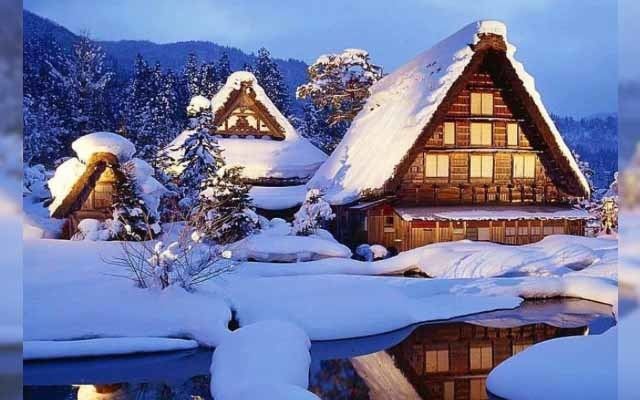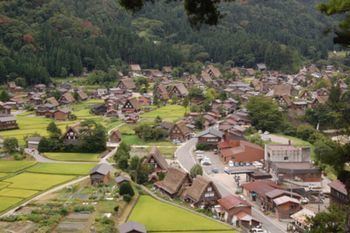Website shirakawa-go.org | Region Chūbū Area 356.6 km² Mayor Shigeru Narihara | |
 | ||
City hall address 517 Hatogaya, Shirakawa-mura, Ōno-gun, Gifu-ken501-5692 Weather -5°C, Wind SE at 6 km/h, 89% Humidity | ||
Shirakawa (白川村, Shirakawa-mura) is a village located in Ōno District, Gifu Prefecture, Japan. It is best known for being the site of Shirakawa-gō, a small, traditional village showcasing a building style known as gasshō-zukuri.
Contents
- History
- Geography
- Climate
- Famous places historic ruins sightseeing spots festivals and events
- Neighboring municipalities
- Sister cities
- Shirakawa in media
- Twin towns Sister cities
- References

As of July 2011, the village has an estimated population of 1,734. The total area is 356.55 km2 (137.66 sq mi).
The village is located near Takayama, in Gifu. Together with Gokayama in Nanto, Toyama, it is one of UNESCO's World Heritage Sites.

History

In 1875, Japan's municipal system was being carried out, and a number of small villages were combined with Miboro village. The river basin in Hida Province was called Shirakawa-gō, and eventually the north side was called Shirakawa, and the upper side (south side) was called Shōkawa, Gifu. It is now called Takayama.
All of the villages and towns in the Hida region participated in the "Hida Area Union Promotion Conference" (飛騨地域合併推進協議会), but due to Nanto and other places connected with the World Heritage sites not wanting the image of Shirakawa-gō to be harmed, as well as domestic and foreign voices, Shirakawa withdrew from the conference and formed its own system. Now, the north part of Gifu prefecture that was in Hida Province has become one unified village; the others were merged into either Takayama, Hida, or Gero.

Due to the income from the tourists who came to see the gassho-zukuri villages, the financial condition was greatly improved. Although the area was famous as a tourist site, once it became a UNESCO site, the area greatly grew as tourists visited. Although this success from tourism helped the income of the area, on the other hand, there was an outbreak of damage to the area from tourists entering people's homes to see how they lived, taking pictures and other such manners. The people who lived in the villages turned their homes into gift shops and parking lots, so it has yet to be seen whether or not the area will lose its World Heritage record (UNESCO has a purpose of protecting and preserving its sites, and becoming a tourist trap is against their goals). There is also a fear growing that the change to catering to tourists will harm the charm of the area's simplicity and fundamental Japanese scenery.
Geography
Shirakawa is a mountain village located at the highest peak on Mount Haku in the Ryōhaku Mountains, where it borders Ishikawa prefecture. To the north it borders Mt. Ningyō, and it borders Gokayama in Toyama prefecture. The village's area is 95.7% mountainous forests, and its steep places are characteristic. In between the mountains flows the Shō River, which continues to the north into Nanto in Toyama. Along the river there are a few flat areas, and human settlements are scattered near them.
One of the snowiest places in Japan, 95.7% of Shirakawa is covered by forests. It touches Ishikawa Prefecture to the west and Toyama Prefecture to the north. The border with Ishikawa Prefecture is made by the Ryōhaku Mountains, and the one with Toyama Prefecture is created by Mount Ningyō. The Shō River flows through the village, and most of the population is inhabited in its valley.
Shirakawa is a leading area of heavy snowfall in the world, and due to this climate, gasshō-zukuri (合掌造り) homes were created. Gassho-zukuri settlements are registered as cultural heritage sites. With the shape of the Hakusan National Park mountain ranges as a background, these sites are major tourist attractions. Upstream on the Shō river are dam lakes like the Miboro (御母衣湖).
Although Shirakawa is in Gifu prefecture, it takes around three hours to get there by bike from Takayama, Gifu, though one can get there in only an hour from Nanto in Toyama. In 1999, an alliance group was formed between Nanto, Toyama (originally several cities in Toyama that now form Nanto) and Shirakawa.
Climate
Shirakawa Village has a humid continental climate (Koppen Dfa). It features four distinct seasons with winter being its most recognized.
Shirakawa Village and its surrounding area are a moderately inhabited area, featuring some of the heaviest snowfall found not just within mainland Japan but the whole world. Yearly average snowfall amounts average out in excess of 10 meters (415.4") with snowbanks developing well over 2 meters tall. As a consequence of the frequent heavy snow, characteristically thick thatched roofed houses are a cultural heritage of this village.
Famous places, historic ruins, sightseeing spots, festivals and events
Neighboring municipalities
Sister cities
Shirakawa in media
Twin towns – Sister cities
Shirakawa-go is twinned with:
